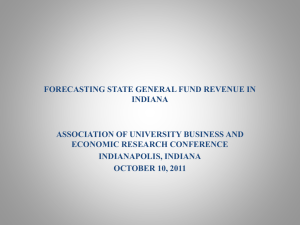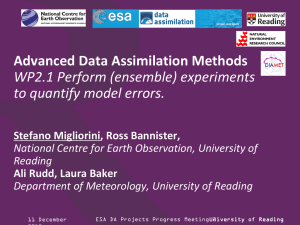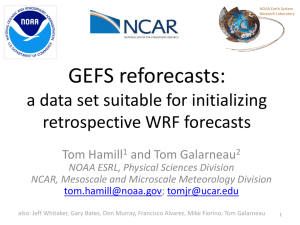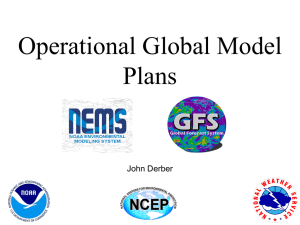Predictability of High Impact Weather during the Cool Season: CSTAR
advertisement
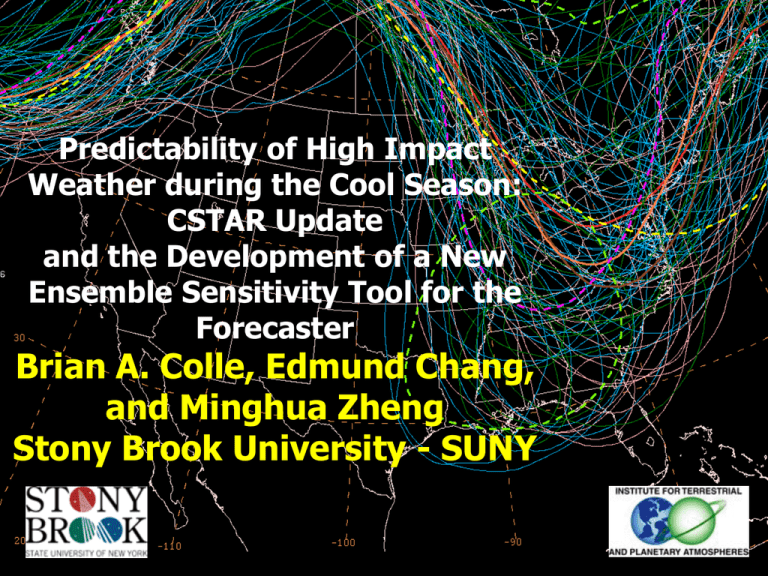
Predictability of High Impact Weather during the Cool Season: CSTAR Update and the Development of a New Ensemble Sensitivity Tool for the Forecaster Brian A. Colle, Edmund Chang, and Minghua Zheng Stony Brook University - SUNY CSTAR Scientific Motivation • Improve the understanding of high • • • impact weather predictability during the cool season through objective verification of cyclones and Rossby wave packets (RWPs) in ensembles. Integrate RWPs more in operations: Better understanding of RWP climatology, downstream impact of targeted observations, and linkage with extreme weather. Better understanding of the predictability of cyclones and some mesoscale phenomena (e.g., snowbands). Better ensemble construction and post-processing. From THORPEX International Science Plan (Shapiro and Thorpe, 2004) Forecasts from 24 Dec 2010 Courtesy: Dan Petersen Forecasts from 25 Dec 2010 Courtesy: Dan Petersen NCEP SREF Cyclone Tracks GDAS analysis 500 mb height/absolute vorticity 00z 24 Dec 2010 GDAS analysis 500 mb height/absolute vorticity 12z 24 Dec 2010 GDAS analysis 500 mb height/absolute vorticity 00z 25 Dec 2010 GDAS analysis 500 mb height/absolute vorticity 12z 25 Dec 2010 GDAS analysis 500 mb height/absolute vorticity 00z 26 Dec 2010 GDAS analysis 500 mb height/absolute vorticity 12z 26 Dec 2010 GDAS analysis 500 mb height/absolute vorticity 00z 27 Dec 2010 500 hPa difference between 06 UTC 24 Dec and 12 UTC 24 Dec runs starting at 18Z 24 Dec From Richard Grumm Objective: Can ensemble sensitivity analysis (Torn and Hakim 2008; 2009) be used to enhance forecaster awareness on how upstream uncertainty is effecting a region of interest? * Ensemble sensitivity is a correlation between a forecast metric at the final forecast time and any variable within the model state vector. It makes use of the different evolution of the forecasts among the different ensemble members to derive the sensitivity. * For CSTAR: Want to use metrics useful to the forecaster: cyclone location and intensity, or why a shift in cyclone forecast between two model runs? * Test for 26-27 Dec nor-easter and hurricane Irene Initial time 12 Z 23 Dec, 84 hour ECMWF ensemble forecast Ensemble mean Dec 27 2010 00Z (84-h fcst) Variance Sensitivity of EOF 1 (cyclone intensity) to 500 hPa height 0-lag Projection of a pattern: “sensitivity” carries the dimension of the forecast metric and describes the change in the forecast metric corresponding to one standard deviation change in the initial condition uncertainties in the selected variable. Pattern: pi Ensemble member anomaly: xi Projection of Pattern onto Ensemble member: S pi xi Basically value of projection is large when the cov(J , xi ) " Sensitivity" cor( J , xi ) var(J ) anomaly of the ensemble member resembles the var(xi ) pattern J is any forecast metric at the final forecast time - xi is any variable within the model state vector (500 hPa height in this example). Here, J is the principal component (PC) of EOF. PCs are the projections of the dominant EOF patterns on each of the ensemble members. EOF1 positive phase: weaker cyclone Sensitivity of EOF 2 (SW-NE cyclone shift) to 500 hPa height 0-lag 00z 27 Dec EOF2 positive phase: southwest shift of cyclone T-48 hr (25/00Z) Sensitivity EOF1 EOF2 Why the shift in cyclone position between 24/00Z and 25/00z run cycles? Using 50-member ECMWF, difference between MSLP ensemble mean forecast at 12z Dec 27 2010. Obtain pattern within red box. Initial time 2010Dec2500Z (60hr) – 2010Dec2400Z (84hr) Here, J is the projection of this “shift” pattern onto each ensemble member at final forecast time (Dec27 12Z) Ensemble sensitivity calculations forecast valid time (Dec27 12Z) positive areas: increasing z at that location is associated with enhancing the corresponding EOF pattern negative areas: decreasing z at that location is associated with enhancing the corresponding EOF pattern ECMWF (50 members): evolution of forecast difference between DEC25Z00 and DEC24Z00 Valid DEC2712Z (0 hr) MSLP (hPa) Z500 (dm) DEC25 00Z * Results from sensitivity analyses suggest that: – Cyclone E-W location at -0 hr (Dec 27 12Z) is sensitive to conditions near the Gulf coast and over northern Canada at -48 to -60 hr – Forecast errors from Dec 24 00Z forecast (comparing to Dec 25 00Z analysis and forecast) also show errors over those sensitive regions – Can we assess the impacts of those short-range (24-hr) forecast errors? – Here, we introduce an alternative way of ensemble sensitivity analysis to examine the “forward” impact of forecast errors at early time on forecasts at later time Region near gulf coast at -60h Z500 difference (m) between Dec2500Z analysis and the 24-h ensemble mean forecast from Dec2400Z Regression based on 500Z projection in black boxed region using forecast ensemble from Dec 24 00Z Note: Regression based on projection of the pattern on each ensemble member can be considered to be weighted mean of ensemble members that have anomalies resembling the chosen pattern MSLP (unit mb) Difference between Dec 25 and Dec 24 forecasts Hurricane Irene EOF 1: a deepening of cyclone; explains 50.5% variance Target time: 2011082800 (5-day forecast) Target region: LON is from 278E to 294E; LAT is from 28N to 42N EOF 2: slower moving Cyclone; explains 24.1 % variance EOF 3: western shifting of cyclone; explains 11.0% variance Ensemble mean SLP and variance Sensitivity of PC1 (deeper cyclone) to 500 hPa height for the target time of 20110828/00Z Sensitivity of PC2 (slower cyclone) to 500 hPa height for the target time of 20110828/00Z Sensitivity of PC3 (western cyclone shift) to 500 hPa height for the target time of 20110828/00Z Real-time Sensitivity Calculations yyyymmddh h MAIN_CSH GET_BIN OUTPUT SENSITIVI TY VARIANCE EOF • Code can run on any workstation (just need GNU Fortran and GrADS) • Currently setting up at NCEP (so ECMWF ensemble can be combined with NCEP) Real-time Sensitivity Calculations Default: • Target time: 6 days forecast initialized either on 00hr or 12hr • Target region: longitude is from 95W to 65W, and latitude is from 30N to 50N Optional run: • target time: 0.5 days forecast to 6 days forecast with an increment of 12h • target region: Forecaster Defined Ensemble Members: • NCEP+CMC combined 40 members ensemble; however. it can also compute sensitivity based on individual NCEP (20 members) or CMC (20members) ensemble. Will be setup at NCEP to include ECMWF ensemble. One Approach 1. There is a large spread is the forecast cyclone position in the ensembles. Forecaster asks: Why are some members closer to the coast and deeper than other members? 2. Forecaster defines his/her sensitivity box around the forecast cyclone in question (forecast hour of interest. 3. Using sensitivity analysis, Forecaster can get some idea of the upstream source of the cyclone spread (Pacific Rossby wave packet in medium range?; shortwave from more data sparse Canada?, …?) 4. If the next model cycle, the storm is closer to the coast, forecaster can confirm whether it was because of changes in upstream flow that sensi analysis suggested. Summary • Ensemble sensitivity approach has been constructed using • metrics useful for the forecaster (e.g., cyclone properties). Can be expanded to other features (300Z jet, snowband position, etc…). The ensemble sensitivity will be run at SBU or NCEP in realtime with results on the SBU CSTAR page: http://dendrite.somas.stonybrook.edu/CSTAR/cstar.html • Results from 26-27 Dec 2010 sensitivity analyses suggest that: – Cyclone location at Dec 27 12Z sensitive to prior conditions (at -48hr to -60hr) near the gulf coast as well as over northern Canada west of Hudson Bay – Short range (24-hr) forecast errors over those locations from forecasts based on Dec 24 00Z apparently led to cyclone being forecast too far east – Hypothesis: Forecasts based on Dec 25 00Z are better because of observations over those regions? Need to confirm with obs denial studies. • Results from hurricane Irene suggest: -- The intensity and speed of Irene has sensitivity patterns suggesting relatively large regional influences from the cyclone itself. -- The western shift of the cyclone for day 5 h suggests some influences from the northern Pacific and downstream development.


